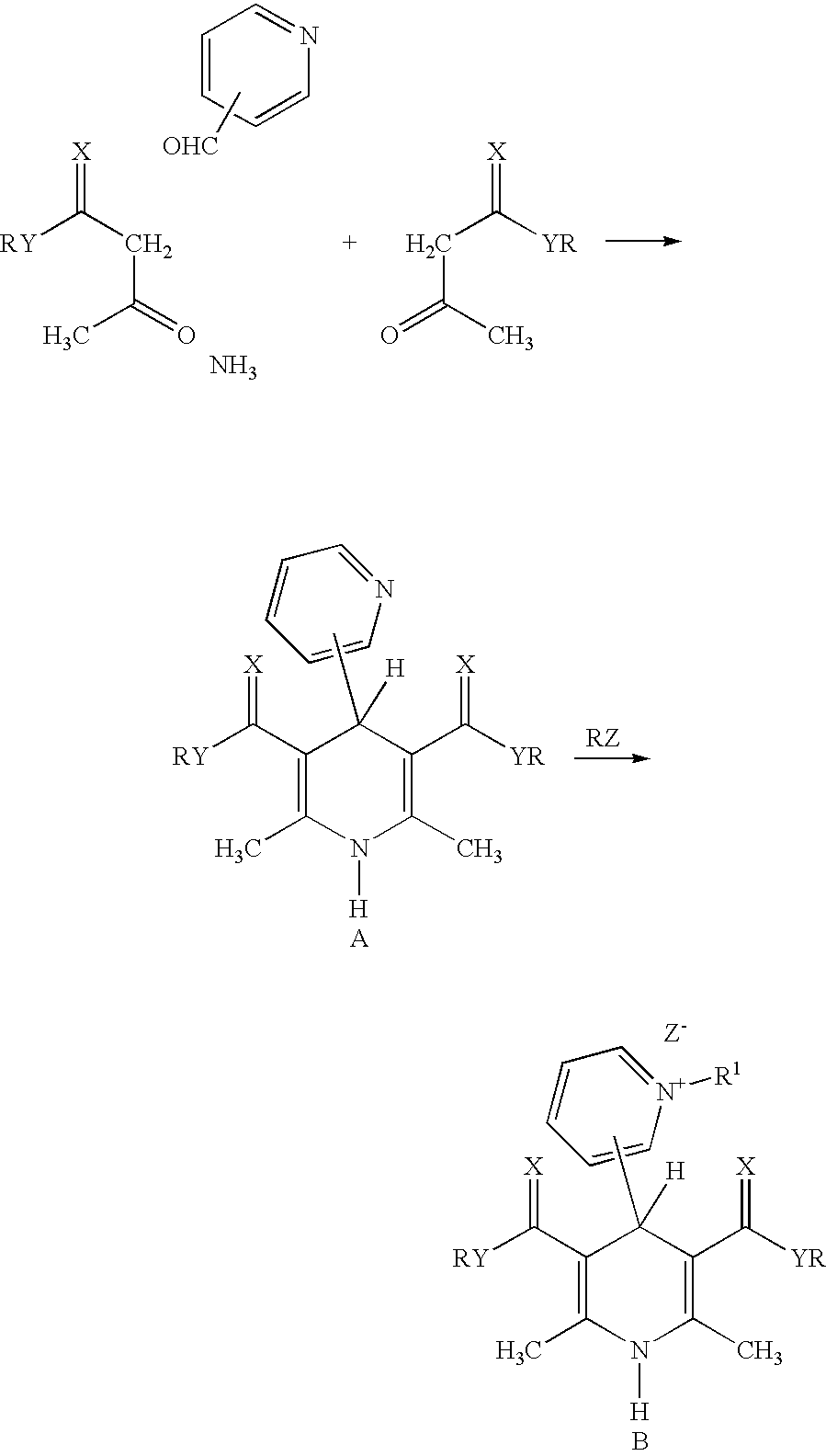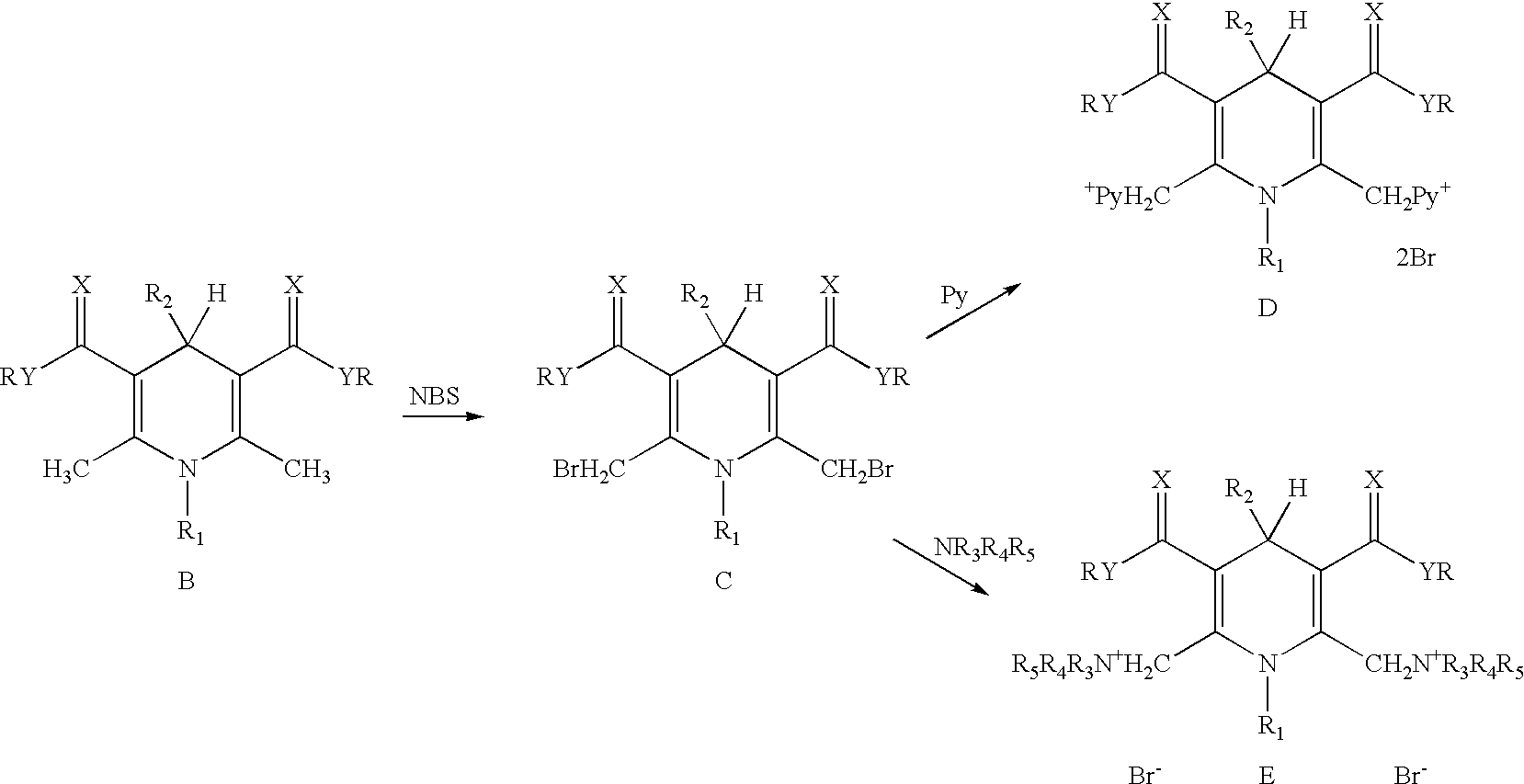Cationic amphiphilic 1,4-dihydropyridine derivatives useful for delivery of nucleotide containing compounds
a technology of dihydropyridine and amphiphilic 1, which is applied in the direction of biocide, plant growth regulator, biochemical apparatus and processes, etc., can solve the problems of preventing the effective entry of nucleotide containing compounds into the cell and its nucleus, enzymatic degradation and inactivation of nucleotide containing compounds, etc., to achieve high transfection efficacy in vitro, efficient and safe compositions
- Summary
- Abstract
- Description
- Claims
- Application Information
AI Technical Summary
Benefits of technology
Problems solved by technology
Method used
Image
Examples
example 2m
[0087] Derivative III (Example 2m)
[0088] 1-Methyl-3-(2',6'-dimethyl-3',5'-dipentadecyloxycarbonylpropyloxyca-rbonyl-1',4'-dihydropyridyl-4')-pyridinium iodide or 1',4'-Dihydro-1,2',6-trimethyl-3,S5'-bis[(3-palmitoyloxypropoxy)carbonyl]--3,4'-bipyridinium iodide (IUPAC name);
[0089] Derivative IV (Example 2g)
[0090] 1-Methyl-3-(2',6'-dimethyl-3',5'-dinonyloxy-carbonyl-1',4'-dihydrop-yridyl-4')-pyridinium iodide or 1',4'-Dihydro-1,2',6'-trimethyl-3',5'-bis(-nonyloxycarbonyl)-3,4'-bipyridinium iodide (IUPAC name);
[0091] Derivative V (Example 2h)
[0092] 1-Methyl-3-(2',6'-dimethyl-3',5'-didodecyloxycarbonyl-1',4'-dihydro-pyridyl-4')-pyridinium iodide or 3',5'-Bis(dodecyloxycarbonyl)-1',4'-dihyd-ro-1,2',6'-trimethyl-3,4'-bipyridinium iodide (IUPAC name);
[0093] Derivative VI (Example 2i)
[0094] 1-Methyl-3-(2',6'-dimethyl-3',5'-ditetradecyloxycarbonyl-1',4'-dihy-dropyridyl-4')-pyridinium iodide or 1',4'-Dihydro-1,2',6'-trimethyl-3',5'--bis(tetradecyloxycarbonyl)-3,4'-bipyridinium iodide (IUPAC ...
example 2j
[0095] Derivative VII (Example 2j)
[0096] 1-Methyl-3-(2',6'-dimethyl-3',5'-dihexadecyloxycarbonyl-1',4'-dihyd-ropyridyl-4')-pyridinium iodide or 3',5'-Bis(hexadecyloxycarbonyl)-1',4'-d-ihydro-1,2',6'-trimethyl-3,4'-bipyridinium iodide (IUPAC name);
[0097] Derivative VIII (Example 2e)
[0098] 1-Methyl-3-(2',6'-dimethyl-3',5'-dipropoxyethoxycarbonyl-1',4'-dihy-dropyridyl-4')-pyridinium iodide or 1',4',-Dihydro-1',2',6'-trimethyl-3',5-'-bis[(2-propoxyethoxy)carbonyl]-3,4'-bipyridinium iodide (IUPAC name);
[0099] Derivative IX (Example 2n)
[0100] 1-Methyl-3-(2',6'-dimethyl-3',5'-di(2,3-dipentadecyloxycarbonyl)-pr-opyloxycarbonyl-1',4'-dihydropyridyl-4')-pyridinium iodide or 3',5'-Bis [(2,3-dipalmitoyloxypropoxy) carbonyl]-1',4'-dihydro-1,2',6'-trimethyl-3,-4'-bipyridinium iodide (IUPAC name);
[0101] Derivative X (Example 2o)
[0102] 1-Methyl-3-(2',6'-dimethyl-3',5'-dimenthyloxycarbonyl-1',4'-di hydropyridyl-4')-pyridinium iodide or 1',4'-Dihydro-3',5'-bis(menthyloxyc-arbonyl)-1,2',6'-trimethyl-3...
example 2s
[0103] Derivative XI (Example 2s)
[0104] 1-Methyl-3-(2',6'-dimethyl-3',5'-dibornyloxycarbonyl-1', 4'-dihydropyridyl-4')-pyridinium iodide or 3',5'-Bis(bornyloxycarbonyl)-1-',4'-dihydro-1,2',6'-trimethyl-3,4'-bipyridinium iodide (IUPAC name);
[0105] Derivative XII (example 2r)
[0106] 1-Methyl-3-(2',6'-dimethyl-3',5'-dicholesteryloxycarbonyl-1',4'-dih-ydropyridyl-4')-pyridinium iodide or 3',5'-Bis(cholesteryloxycarbonyl)-1',-4'-dihydro-1,2',6'-trimethyl-3,4'-bipyridinium iodide (IUPAC name);
[0107] Derivative XIII (Example 6a)
[0108] 1-Nonyl-3-(2',6'-dimethyl-3',5'-diethoxycarbonyl-1',4'-dihydropyrid-yl-4')-pyridinium bromide or 3',5'-Bis(ethoxycarbonyl)-1',4'-dihydro-2',6'--dimethyl-1-nonyl-3,4'-bipyridinium bromide (IUPAC name);
[0109] Derivative XIV (Example 6b)
[0110] 1-Nonyl-3-(2',6"-dimethyl-3,5"-ditetradecyloxycarbonyl-1',4'-dihydr-opyridyl-4')-pyridinium bromide or 1',4'-Dihydro-2',6'-dimethyl-1-nonyl-3'-,5'-bis(tetradecyloxycarbonyl)-3,4'-bipyridinium bromide (IUPAC name);
PUM
| Property | Measurement | Unit |
|---|---|---|
| temperature | aaaaa | aaaaa |
| temperature | aaaaa | aaaaa |
| temperatures | aaaaa | aaaaa |
Abstract
Description
Claims
Application Information
 Login to View More
Login to View More - R&D
- Intellectual Property
- Life Sciences
- Materials
- Tech Scout
- Unparalleled Data Quality
- Higher Quality Content
- 60% Fewer Hallucinations
Browse by: Latest US Patents, China's latest patents, Technical Efficacy Thesaurus, Application Domain, Technology Topic, Popular Technical Reports.
© 2025 PatSnap. All rights reserved.Legal|Privacy policy|Modern Slavery Act Transparency Statement|Sitemap|About US| Contact US: help@patsnap.com



